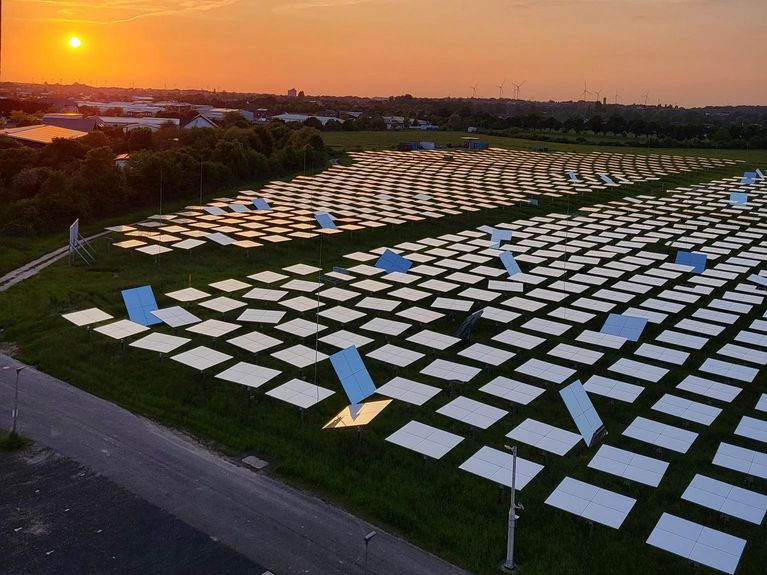Helmholtz AI researchers, in collaboration with DLR, develop AI-driven heliostat optimization for cost-effective solar thermal power plants

Solar thermal power plants work in a very simple way: thousands of heliostats – a fancy word for sun-tracking mirrors – reflect sunlight to generate heat, which can then be used for electricity production or industrial applications like cement manufacturing. These heliostats, however, are a significant cost factor in operating a solar thermal power plant.
Solar thermal power plants work in a very simple way: thousands of heliostats – a fancy word for sun-tracking mirrors – reflect sunlight to generate heat, which can then be used for electricity production or industrial applications like cement manufacturing. These heliostats, however, are a significant cost factor in operating a solar thermal power plant. To address this, researchers from the German Aerospace Center (DLR), together with Helmholtz AI consultants from Jülich Research Center (FZJ) and Karlsruhe Institute of Technology (KIT) have developed a new AI-based method to easily detect irregularities in the mirrors. Their findings were published in Nature Communications.
Max Pargmann | German Aerospace Center (DLR) · Department of Point Focus Systems
At a test facility in Jülich, operated by the German Aerospace Center (DLR), nearly 2,000 mirrors are aligned to reflect sunlight onto an absorber atop a tower. These solar tower power plants can complement wind and photovoltaic energy as a renewable energy source. The heat they concentrate can be used to generate electricity, power thermal industrial processes, or even stored for use during nighttime or in calm wind conditions. Like other renewable technologies, solar thermal power plants face significant cost pressures. To stay competitive, cost-saving measures are essential. Given that heliostats are a key expense, optimizing their production and performance is crucial. Currently, the mirrors are not perfectly flat, leading to uneven heat distribution at the tower, requiring high safety margins and thus reducing efficiency. "We need to know precisely how much energy is being delivered at each point," explains Max Pargmann, a postdoc at DLR. "Until now, no technology reliably provided this data, which poses challenges for plant operations."
Jan Ebert | Helmholtz AI Consultant at the Jülich Research Center (FZJ)
To solve this, the Helmholtz AI teams from the Jülich Research Center (FZJ) and the Karlsruhe Institute of Technology (KIT) collaborated with DLR. "We quickly came up with a great idea," says Jan Ebert, Helmholtz AI consultant at FZJ. "We applied a technique from AI, known as backpropagation, in our simulation of the heliostats." Backpropagation is an algorithm typically used to train neural networks. In the case of the concentrating solar power plants, however, it learns a model of the mirror surfaces. This surface model is then used to calculate solar reflections at the tower using ray tracing, a technique from computer graphics. "With our backpropagation ray tracing, we can calculate how to adjust the mirror surface so that the computer simulation’s reflections closely match those from images taken at the real solar tower," Ebert explains. Unlike other AI methods, this approach requires minimal data – just a few images are enough to produce accurate predictions. The researchers call this a reverse method because the mirror surface, typically an input for simulation, is instead the output.
Markus Götz | Helmholtz AI Head of Consultants at the Karlsruhe Institute of Technology (KIT)
This new calculation method marks a significant step towards reducing the cost of solar power plants. According to a U.S. Department of Energy report, decreasing the thickness of mirror material from four to three millimeters could save up to three million dollars per plant. "The Jülich site is just a test facility," says Pargmann. "In large-scale plants in Spain or Morocco, there could be up to ten thousand mirrors, much larger than those in Jülich." Once the surface of each mirror is known, energy distribution can be precisely controlled through optimal alignment. The next step is an operational integration into plant operations. Potentials for future improvements are vast: "We aim to account for alignment errors or dynamic deformations caused by factors like gravity and windfor an entire heliostat field," Markus Götz, head of the Helmholtz AI consultants at KIT notes.
Through their collaboration, the Helmholtz AI researchers, along with their DLR partners, have made a significant contribution to the advancement of green energy technologies. Their innovative approach not only enhances the efficiency and affordability of solar thermal power plants but also paves the way for more sustainable and scalable renewable energy solutions in the future.